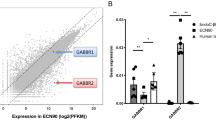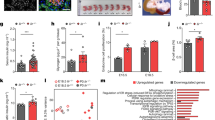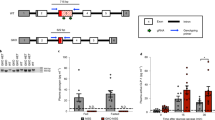Abstract
Many cell-surface receptors for hormones appear to exert their effects on target cells by interacting with specific guanine nucleotide binding regulatory proteins (G-proteins) which couple receptors to their second-messenger signal generation systems. A common intracellular second messenger, which is used by many hormones, is cyclic AMP. This is produced by adenylate cyclase, whose activity is controlled by two G-proteins, Gs which mediates stimulatory effects and Gi inhibitory effects on adenylate cyclase activity1. In liver, the hormone glucagon increases intracellular cAMP concentrations by activating adenylate cyclase by a Gs-mediated process. This effect of glucagon is antagonised by the hormone insulin, although the molecular mechanism by which insulin elicits its actions is obscure. However, insulin receptors exhibit a tyrosyl kinase activity2 and appear to interact with G-proteins2,3, perhaps by causing phosphorylation of them4. In type I diabetes, circulating insulin levels are abnormally low, giving rise to gross perturbations of metabolism as well as to a variety of complications such as ionic disturbances, neuropathies of the nervous system, respiratory and cardiovascular aberrations and predispostion to infection5. We show here that experimentally-induced type I diabetes leads to the loss of expression of G{ in rat liver. As it has been suggested that Gi may couple receptors to K+-channels6,7 as well as mediating the inhibition of adenylate cyclase, aberrations in the control of expression of this key regulatory protein in type I diabetes may be expected to lead to pleiotropic effects.
This is a preview of subscription content, access via your institution
Access options
Subscribe to this journal
Receive 51 print issues and online access
$199.00 per year
only $3.90 per issue
Buy this article
- Purchase on Springer Link
- Instant access to full article PDF
Prices may be subject to local taxes which are calculated during checkout
Similar content being viewed by others
References
1. Houslay, M. D. Trends biochem. Sci. 9, 39–40 (1983). 2. Houslay, M. D. Molec. Asp. cell Reg. 4, 279–333 (1985). 3. Heyworth, C. M., Whetton, A. D., Wong, S., Martin, B. R. & Houslay, M. D. Biochem. J. 228, 593–603 (1985). 4. O'Brien, R. M., Houslay, M. D., Milligan, G. & Siddle, K. FEES Lett. 212,281–288 (1987). 5. Wilson, R. M. & Reeves, W. G. Recent Adv. Diabetes 2, 127–138 (1986). 6. Martin, J. M., Hunter, D. D. & Nathanson, N. M. Biochemistry 24, 7521–7525 (1985). 7. Yatani, A., Codina, J., Brown, A. M. & Birnbaumer, L. Science 235, 207–209 (1987). 8. Heyworth, C. M., Hanski, E. & Houslay, M. D. Biochem. J. 222, 189–194 (1984). 9. Itoh, H., Okajima, F. & Ui, M. /. biol. Chem. 259, 15464–15473 (1984). 10. Hildebrandt, J. D., Hanoune, J. & Birnbaumer, L. /. biol Chem. 257, 14723–14725 (1982). 11. Katada, T. & Ui, M. /. biol Chem. 257, 7210–7216 (1982). 12. Pushpendran, C. K., Corvera, S. & Garcia-Sainz, J. A. FEBS Lett. 160, 198–202 (1983). 13. Itoh, H. et al. Proc. natn. Acad. Sci. U.S.A. 83, 3776–3780 (1986). 14. Nukada, T. et al FEBS Lett. 197, 305–310 (1986). 15. Heyworth, C. M., Wallace, A. V. & Houslay, M. D. Biochem. J. 214, 99–110 (1983). 16. Houslay, M. D. & Elliott, K. R. F. FEBS Lett. 104, 359–363 (1979). 17. Heyworth, C. M., Grey, A–M., Wilson, S. R., Hanski, E. & Houslay, M. D. Biochem. J. 235, 145–149 (1986). 18. Sauerheber, R. D., Kuhn, C. E. & Hyslop, P. A. Diabetes 33, 258–265 (1984). 19. Milligan, G., Gierschik, P., Spiegel, A. M. & Klee, W. A. FEBS Lett. 195, 225–230 (1986). 20. Tanabe, T. et al Nature 315, 242–245 (1985). 21. Yatsunami, K. & Khorana, H. G. Proc. natn. Acad. Sci. U.S.A. 82, 4316–4320 (1985). 22. Falloon, J. et al. FEBS Lett. 209, 352–356 (1986). 23. Milligan, G. & KJee, W. /. biol Chem. 260, 2057–2063 (1985).
Author information
Authors and Affiliations
Rights and permissions
About this article
Cite this article
Gawler, D., Milligan, G., Spiegel, A. et al. Abolition of the expression of inhibitory guanine nucleotide regulatory protein Gi activity in diabetes. Nature 327, 229–232 (1987). https://doi.org/10.1038/327229a0
Received:
Accepted:
Issue Date:
DOI: https://doi.org/10.1038/327229a0
This article is cited by
-
A role for heterotrimeric GTP-binding proteins and ERK1/2 in insulin-mediated, nitric-oxide-dependent, cyclic GMP production in human umbilical vein endothelial cells
Diabetologia (2005)
-
Impairment of endothelium‐dependent but not of endothelium‐independent dilatation in guinea‐pig aorta rings incubated in the presence of elevated glucose
British Journal of Pharmacology (1997)
-
The guanine nucleotide-binding regulatory proteins (G proteins) in myocardium with ischemia
Molecular and Cellular Biochemistry (1996)
-
Striatal dopaminergic D1 and D2 receptors after intracerebroventricular application of alloxan and streptozocin in rat
Journal of Neural Transmission (1995)
-
Selective attenuation of neuropeptide-Y-mediated contractile responses in blood vessels from patients with diabetes mellitus
Clinical Autonomic Research (1995)
Comments
By submitting a comment you agree to abide by our Terms and Community Guidelines. If you find something abusive or that does not comply with our terms or guidelines please flag it as inappropriate.



